绍兴 (Shàoxīng)
绍兴1 (Shàoxīng) is a city south of Hangzhou Bay in 浙江2 (Zhèjiāng) Province, 中华3 (Zhōnghuá) People's Republic. It came into significance as the main city of the people the Chinese called Yue, 4 by 430 BCE being the area's largest urban place. By 200 BCE the Chinese had conquered the city and called it 會稹5 (Kuàijī), a name that persisted until the 12th century. In recent decades the city (shi) limits have expanded to take in the entire prefecture. The prefectural population was 4.912 million according to the 2010 census. I would view the metropolitan area as smaller, having 4.532 million.6 The tallest building as of late summer 2016 was the Shimao Didang New City Main Tower (919 feet, 56 stories, 2012).7 A part of the Grand Canal system is within the city.8 The shores of the city are one of the places where a tourist can view the Qiantang tidal bore.9
| Year | Population | Political entity |
| 430 BCE | 75,00010| Yue4 | |
| 1800 CE | 30,00010| Qing Empire (China) | |
| 1900 CE | 90,00010| Qing Empire (China) | |
| 2000 CE | 3,097,00011| 中华 (Zhōnghuá or Chinese) People's Republic) | |
Historical Maps



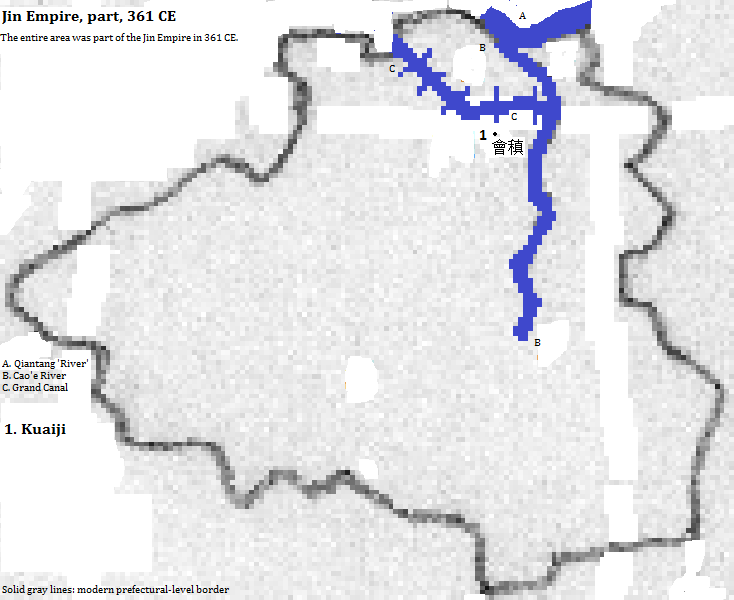
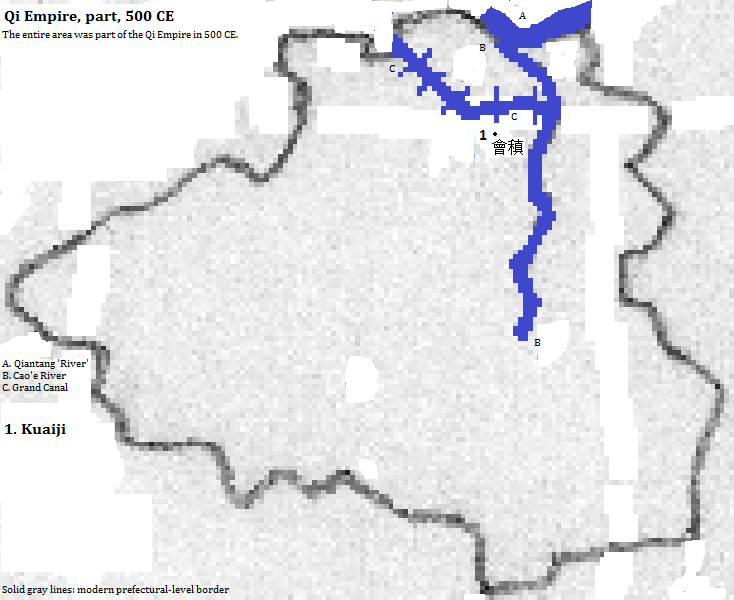
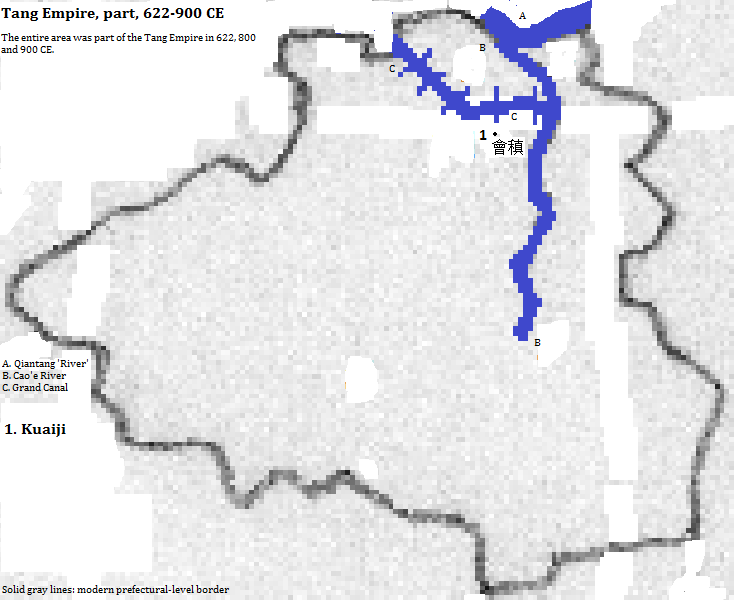

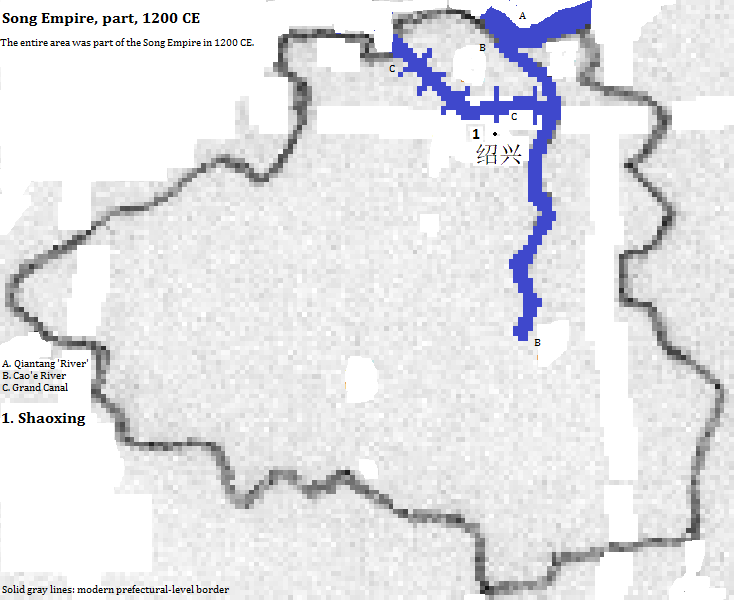
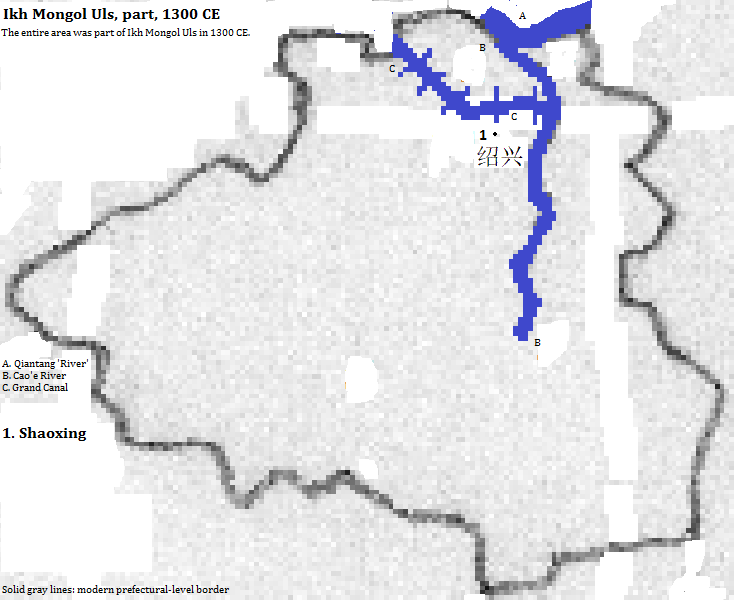
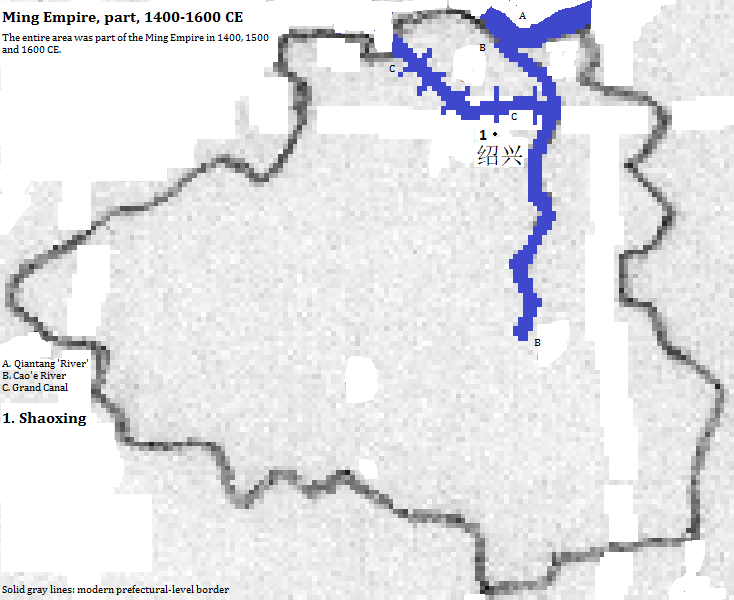


External references
A waterway in Shaoxing, with skyscrapers in the distance, Zhèjiāng Province, Zhōnghuá People's Republic
Footnotes
1. Shàoxīng or Shao-hsing or Shausying are transliterations from Pŭtōnghuà Chinese. It is also called Shaohing (former postal designation based on the Nanjing dialect). The first character means to connect or join, and the second to flourish or prosper. In the Wu dialect group it transliterates as Sohshing.
2. Zhèjiāng or Che-Chiang or Jejyang in transliterated Pŭtōnghuà Chinese. It is also called Chekiang (former postal designation based on the Nanjing dialect). The first character is a phonetic marker coupled with the water radical. In reconstructed Old Chinese it was pronounced like tet, and was a proto-Wu term for the Yue people according to https://en.wikipedia.org/wiki/Zhejiang, accessed August 10, 2016. The second character means river.
3. Zhōnghuá or Chung-hua or Junghwa in transliterated Pŭtōnghuà Chinese. The first character means central and the second means Chinese/ illustrious/ flowery. China is its English name. In the Wu dialect group it transliterates as Tsonkoh.
4. This is a transliteration of the characters in the modern national dialect. I do not know what the Yue people called themselves, their state or their chief city.
5. In today's simplified characters it would be 会稹. Kuàijī or K'uai-chi or Kwaiji are transliterations from Pŭtōnghuà Chinese. The first character means to meet or to gather and the second, to bow low or inspect. In the Wu dialect group it would be transliterated as Kwaeji.
6. This excludes one county (xian) but includes all the districts (qu) and the two county-level cities (shi). The amount of the exclusion also comes from the 2010 census.
7. Emporis.com, accessed September 15, 2016.
8. UNESCO honors as part of the Grand Canal World Heritage Site the Shangyu-Upao Section of the Zhedong Canal, which is partly in Shaoxing, and the Hangzhou Xiaoshan-Shaoxing Section of the Zhedong Canal, which is also partly in 绍兴 (Shàoxīng).
9. My list of tourist attractions for the province came from a combination of two sources: first, http://www.china.org.cn/top10/2012-06/04/content_25538813.htm (Zhejiang tourism, accessed August 3, 2016)--first five only (rest errored out, which were really the top five as the list was backward-ordered)--but I eliminated the first one (that is number ten by rank) since I only wished for nine total; and second, https://www.tripadvisor.com/Attractions-g297468-Activities-Zhejiang.html--top five, accessed August 3, 2016.
10. Tertius Chandler, Four Thousand Years of Urban Growth, 2nd ed. (The Edwin Mellen Press, 1987), "Tables of World's Largest Cities". In 430 BCE it was the largest city in what is now 浙江 (Zhèjiāng) Province, and the ninth largest city in the world.
11. https://www.citypopulation.de/php/china-zhejiang-admin.php (accessed Aug. 2, 2016) provided the prefectural and sub-prefectural populations for 2000. https://en.wikipedia.org/wiki/List_of_administrative_divisions_of_Zhejiang, accessed on the same date provided the list of administrative changes 2000 to date, specifically that Shaoxing County was upgraded to Keqiao District. Adding Keqiao District to the list of exclusions brings the metropolitan population down to 3.907 million, with the shi without exclusions having 4.304 million in 2000 CE.












